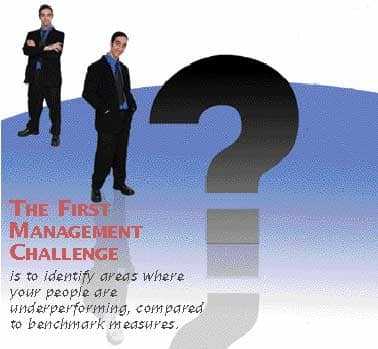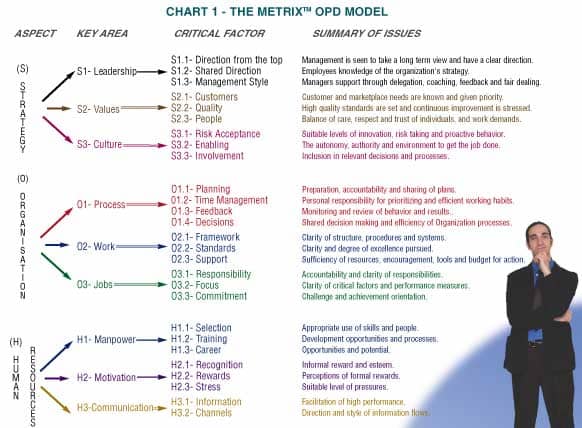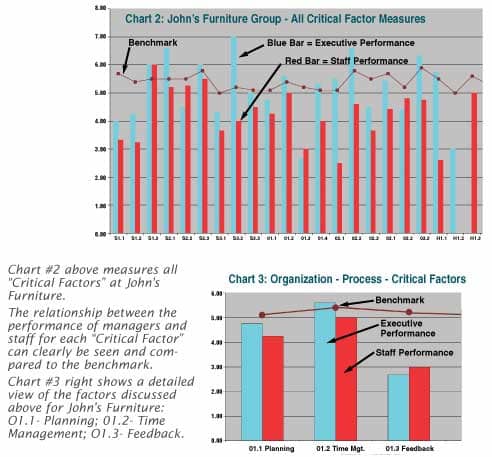How often have you felt the frustration of wanting to get more performance out of your employees? You know they can achieve more, and you believe they want to do their best. Still you may not be able to achieve the results you desire through them.

The first part of this series of articles gives an overview of a technique that allows retail managers to measure and then direct job performance enhancement. This approach has proven to be more valuable than subjective and cumbersome “attitudinal” surveys, because it incorporates statistical tools that allow retailers to trust the perceptions of employees as measured by the technique. Furthermore, multiple survey results identify organizational trends and provide important benchmarks that are so important for steady performance improvement.
Obtaining optimum performance from workers is one of the most urgent issues facing major home furnishings retailers as well as independent furniture stores. It defines the essence of their competitive edge. If workers achieve less than optimum performance, they will be soft, dull and underperforming. In other words they suffer from poor productivity.
Organizations in most industries spend endless hours looking for the ways to increase technical productivity. Although the furniture business has lagged behind, we’ve seen that even a 5% gain in productivity speaks to the bottom line and boosts competitive performance.
What would it mean for your organization if every one of your salespeople increased sales volume by 20% without increasing any of the costs of sales? What would it mean if your clerical staff increased their activity by 25% in the same eight hour day?
These gains may feel unattainable, but they can be achieved for most furniture businesses. Businesses that have access to the proper tools have found a way to do it. They’ve been able to produce more, sell more, distribute more and service more goods per employee than the rest of our industry. They have unlocked the key to people productivity.
How have they done this? They’ve focused their attention on six key areas that affect employee productivity. These are: Motivation, Job satisfaction, Better technology, Better processes, Innovative benefits programs and Better pay.

Many retail managers intuitively recognize these six general areas as the ones traditionally addressed in seeking performance improvement. The problem with using them as stated is that they don’t provide a fine enough understanding of business challenges to direct a specific course of action. It is one thing to know that your people lack motivation. It is another to be able to find that, for example, motivation has elements within it that relate to management direction, leadership or even corporate culture. As our knowledge of business processes has become more sophisticated, we’ve been able to more accurately describe these processes, first in terms of the 9 factors described below and then eventually 27 factors that allow analysis to have much greater practical value.
As business owners or managers we must understand that increasing the productivity of people cannot be accomplished by finding an “instant cure”, taking a “productivity pill”, or by making a one-time “quick fix”. It comes from putting your energy and resources to bear on the appropriate factors at the appropriate times in a consistent way.
Toward this end, your first priority should be to recognize how much more you can accomplish by helping your employees to become more productive, rather than trying to manage the factors that influence productivity.
One of the traditional ways managers have tried to influence productivity is by exercising management “control”. This technique is based on the historic notion that managers should make decisions, tell people what to do, monitor results, provide feedback and accept responsibility for these results. This model implies that employees are, therefore, simply expected to do what they are told to do.
The top down “control” model is clearly out of step with workers and doesn’t fit the needs of today’s competitive environment. Instead, employee involvement and participation are called for. Home Furnishings retailers of any size can reap huge benefits if they spread the burden of responsibility for results among workers. Instead of management control, managers can improve productivity through actions such as:
- Sharing of information.
- Creating a collective vision.
- Asking for input in the decision making process.
- Informing others of decisions and the reasons for those decisions.
- Helping the workforce to be committed and fully
responsible.
Our work has identified nine factors that influence the productivity of people in the workplace.

These factors are: Leadership, Values, Culture, Process, Work, Jobs, Manpower, Motivation and Communication.
The first management challenge is to identify areas where your people are underperforming, compared to benchmark measures. You will then need to find solutions that can be best applied to your people and unique organization.
These “factors” can be compared to buttons on a dashboard or instrument panel. When pressed, any of these business-critical buttons will resolve one particular issue.
Unfortunately, in this example, the buttons aren’t clearly labeled and time constraints only permit you to push one button! The challenge for you is, therefore, to find out what each button does and label it. Then, given limitations, identify the button that needs, most urgently to be pushed to give the greatest return or satisfactory solution to an issue at hand.
“Attititudinal surveys” that ask store managers, line employees and customers about their perceptions tend to be subjective and qualitative and are not able to address such an approach. What is needed is a model that can assess your organization in its entirety with all of its labyrinth interconnections relating to culture, politics, business functionality, and people aspects.
There are many business models that purport to help mangers understand these “buttons”. Most do to some extent, however, research with a number of companies over the past ten years has led to the development of a model that is much better. This model identifies factors or buttons that influence the productivity of people. It has also generated a set of benchmarks or standards. These standards enable managers to position their organization on a growth curve, by helping to identify which button needs to be pressed when.
THE METRIX ™_ OPD MODEL
METRIX™ OPD uses a core survey comprising 140 internationally validated and benchmarked questions. These enable the measurement of developments in the Aspects of Strategy, Organization Development and Human Resources. They are further subdivided into 9 Key Areas and 27 Critical Factors. Using this model managers can:
- Identify the appropriate buttons or factors that enable them to manage more effectively in real time.
- Have a set of standards that will tell them how well they are doing today.
- Determine which button or buttons need to be pressed for a particular situation.
The end result is people who are more productive and more committed to the work they are doing. Productive people accept full responsibility for their jobs and make a full commitment to both the quality and quantity of their work.
Most organizations address several of these factors well, other factors not so well. When times get tough, managers will usually look for more results in areas where they already excel rather than addressing the factors that could use the most improvement.
he METRIX™ OPD model answers these questions for managers and their organization:
- What are these important factors that influence the productivity of my people?
- What are the norms or standards that I can use as a basis for comparison?
- Which factors are working well in my organization today?
- Which factors need improvement in my organization?
Answering these questions regarding productivity is the most challenging task facing a manager today. The commitment effort, however, makes the difference between merely “surviving” or being a growth orientated, profitable business.
The next stage is to be able to see these results in a way that can be used by managers.
Example: John’s Furniture Group
An example of how such an approach can be helpful, is easily seen by looking at the case of John's Furniture Group.
Situation: John (the owner) and his senior managers have, for some time, been concerned that the John’s Furniture staff lacks motivation and commitment to their jobs. This has created a work environment that seems to negatively effect productivity as well as their customers’ experience. There is higher than average turnover in staff and managers have overheard comments coming from staff about "managers not leading the business" or " does anyone know where this business is going" or "we are like a rudderless ship". Several of the organization’s plans to open new outlets and negotiations with vendors to install cooperative merchandising concepts have fallen behind schedule.
Review: John speaks to his department managers and staff members but can't pinpoint the cause of the problem.
Instead employees tend to blame coworkers, managers and failures by other departments. These informal interviews highlight the level of organizational discontent but their lack of substance doesn’t identify specific courses of action that might be taken. As a result, John arranges for a formal survey to be taken and reviews the results.
Survey Results: The survey highlights several areas of concern, but John’s attention is drawn to the analysis of “Organization”. Looking at the detailed report, he was able to identify the causes that are graphically depicted in charts #2 and #3 on the following page.
Problem #1
The first area of concern turns out to be the extent to which people in the organization have meaningful, shared action plans... identified on Chart 1 as follows:
(O) - Organization: The processes, work parameters and job design.
O1 - Process: Involvement in planning, monitoring and adjusting activity.
O1.1 - Planning: Preparation, accountability and sharing of plans.
Outcome: Managers at John’s Furniture have an inconsistent approach to the planning process with a tendency to use a crisis management style. Analysis shows that a more balanced and proactive approach needs to be undertaken. Specifically, managers need to learn to “task” their people more clearly and encourage the involvement of others in order to maximize effort. There is a need to undertake some training in the area of project planning and management to work toward this result.
Problem #2
A second area identified is O1.2 – Time management: Personal responsibility for priorities and efficient working habits. This area measures the extent to which priorities are set, understood and acted upon regardless of the potential for less important distractions.
Outcome: There appears to be an overwhelming understanding and a clear sense of priority within members of the senior team. This encourages a single focus on the key tasks that underpin the business processes. The results suggest that these managers have effective control over their own time management and the demands put upon them. It also indicates they have a clear idea of the objectives that need to be pursued to help the business to succeed. However, it can be seen that the staff is not aware of this management strength. Instead, they see a management weakness within this area, a fact that requires immediate remediation.
Problem #3
A third area of concern is O1.3 – Feedback: Monitoring and review of behavior and results. This assesses the quality of performance related feedback that people receive from their managers. i.e. the extent to which it is seen to be adequate, clear, constructive, positive, regular and formal.
Outcome: It appears that staff members do not understand that the executives have a clear vision of the important priorities facing the business. This failure does not encourage a single focused effort by staff memebers to achieve key tasks that are important to the smooth running of important business processes. Neither do staff members have effective control over their own time management or the demands put upon them. Finally, the data shows that the staff has a poor understanding of the objectives established by management that are necessary to ensure the success of John’s Furniture.
ACTION PLAN
After reviewing the survey results, John sets up a number of initiatives within the organization to ensure that improvements are quickly and effectively realized.
- Monthly management meeting.
- Cascade of information from managers down through the organization.
- Monthly informal meetings between managers and staff.
- Quarterly newsletter to all staff.
- Owner set in place a formal review with each of his
managers.
- Owner walks the floor weekly to get a feel for staff
perception within his staff.
NEXT ISSUE
In the next issue of FURNITURE WORLD Magazine, Philip Pugh will take a closer look at ways to develop and implement action plans based on his model.
Philip Pugh, an experienced consultant and Business Manager specializing in Process and Organizational improvement and is the Operations Director for Tribune US, Inc (TUS) a consulting company based in Washington DC. Tribune US, Inc. TUS is a subsidiary of Tribune Business Systems Ltd., a London based company. TUS offers a range of products and services to customers in the Retail, Financial Services, Insurance and Manufacturing sectors.
Tribune US, Inc is a recognized specialist in the field of Process Management and Process efficiency with applications to assist in continuous improvement. If you have questions about this article contact Mr. Pugh at pugh@furninfo.com.